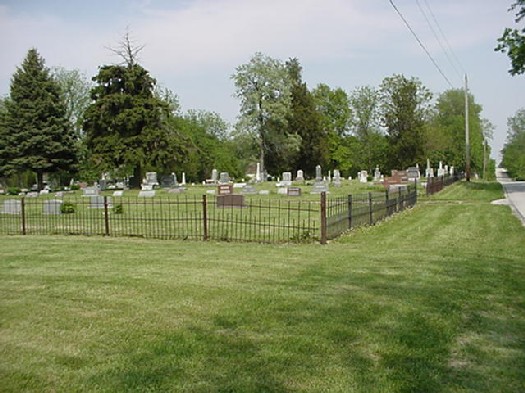 |
 |
 |
| The following short history
of Liberty Chapel Church and Liberty
Chapel Cemetery was transcribed and submitted by Steve
Harvey.
Mrs. Ada Brown Dailey was a distant relative of mine. She passed away in 1976. Her genealogy linage traces back to Ross County, Ohio where our two families, Brown and Harvey, started to intermarry in 1825. Both families came to Tippecanoe County with other families around 1830. Intermarrying with other families around County Road 900 N. there can still be found descendants living in the region today. For the June 4th 1960 edition of the Lafayette Journal and Courier she wrote this article. Liberty Chapel And It's Cemetery For years Mrs. Ada Brown Dailey has had a special interest in the Liberty Chapel Church west of Battle Ground. From clippings in her mother's scrapbook, she has reconstructed the church's history since 1828 when the Rev. Moses Wood was the Pastor and Mrs. Dailey's great aunt, Mrs. Rachel McCormick, was the song director. Those were the days when members carried bound Bibles and Prayer Books, many with metal clasps, and tucked in a pocket was a song book, all words and no music. It was not uncommon for snow to drift over the rail fence which encircled the log church, but hearty members merely shuffled along on top of the drifts. The church, which stood in the southwest corner of the present cemetery, was always crowded on Sundays, said the late Mrs. Mary Ann Work, an untiring Sunday School worker. In 1867 a frame church, quite a handsome structure for the day, was built across the road on ground purchased for $500 by George Taylor from Cheesebrough and Catherine Taylor. Donated, besides the members' labor, were 90 trees by William Kendall and the other Trustees. The United Brethren Church was named Cairo. Timber for
the building was hand hewed by Mrs.
Dailey's
father, William C. Brown and her grandfathers, Peter
O.
Brown and John P. McCormick. Near neighbors who
helped
were William Kendall, George Taylor, Guilford Smith, Henry King,
David
Archibald, John R. McAfee, Silas Long, David Clevenger, Bazil
Clevenger,
Hiram Moore, Ira Heman, Walter Gipson, Abraham Timmons, William
Stewart,
Elza Graves, Ed Joyce, Rooney Ridgway, James Ridgway, Erastus Barnes and
Henry
Work.
In those days the presiding Elders received the tidy sum of $13 for preaching five sermons. The minister was paid $400 a year. The first winter after the church was built was a rugged one. So much snow fell that the men made bobsleds and hitched ox teams. At house after house teams would stop, picking up church goers for the Sunday morning services and for those at night. Those who had mules and horses rode them to services and a few, apparently with money, used three-seated spring wagons. The Tippecanoe River, a few miles from the church, was a familiar to all members for there baptismal services were conducted in the Summer and there Sunday School picnics were spread in cool groves. Logs for the church were hand hewed and pulled into place by three ox teams owned by Mrs. Dailey's grandfathers. Trim for the building was finished in a sawmill owned by her uncle, John R. McAfee who also supplied tile for drainage. A trip into Lafayette was made by James Ridgway who purchased the church bell and hauled it out to the site in his farm wagon. His 11 year old daughter, Mary Ellen, who vowed she would be the first to ring the bell, climbed up to the belfry and rang it before a rope was attached. In those old days seating arrangements still followed that established in colonial days. Men sat on the East side, women on the West. In one section was the "Amen" corner reserved for Elders and Deacons. Two wood-burning stoves warmed members and the Minister who presided from a carved pulpit enclosed by a railing. For over 30 years two denominations - United Brethren and Methodist - shared the church. The arrangement worked quite well with the United Brethren Congregation worshipping and conducting Sunday School in the morning, The Methodist using the church in the afternoon. When a young Methodist Minister, Rev. Jesse Jenkins, arrived to head his congregation trouble began to brew. Jenkins insisted that the United brethrens join the Methodist congregation, a suggestion which was turned down flat. Unable to enforce his suggestion, Rev. Jenkins moved a quarter of a mile West and built a new Methodist church, naming it New Cairo. The designations were confusing, so in 1889 the United Brethren Conference changed the name of the original Cairo Church to Liberty Chapel. Before the United States entered World War I, in 1916, the Liberty Chapel Church was remodeled from pulpit to furnace. Ministers during those years, from the time of the church's opening, were Frank Ferguson, Moses Wood, Aaron Wood, E. A. Goodwin, Marion Tuggle, Erastus Barnes, R. H. Blackburn, A. N. Sallaz, H. W. Meredith, Austin A. Pellet, Ed Cooper, L. M. Augenbaugh, T. C. Walker, Frank Highley, I. H. Ade, William Zimmerman, O. W. Moore, Wilbur Harmon, M. A. Wake, G. R. Chaplin, James Campbell, Stacy Shaw, J. D. Smith, Donald Littler, Ralph Cunningham, Guy Tremaine. Serving as the Minister in 1960 was Oscar J. Schinkel at the time of this writing. Since the first half of the 19th Century, when members walked over snow drifts to get to church, the Elders have become Superintendence, and two denominations have become one. After the Evangelical and United Brethren denominations merged (November 16, 1946) at Johnstown, Pa., the country church has been known as Liberty Chapel Evangelical United Brethren Church. The latest tally is 115 members of whom 41 are non-resident. One of the oldest of the non-residents was the late Mrs. Jennie Tremaine. Although the church is small it has a
devoted
congregation which has kept the building in good repair. |
History of Liberty Chapel © 2004 Steve Harvey
Photos by LA Terry-Clugh © 2001